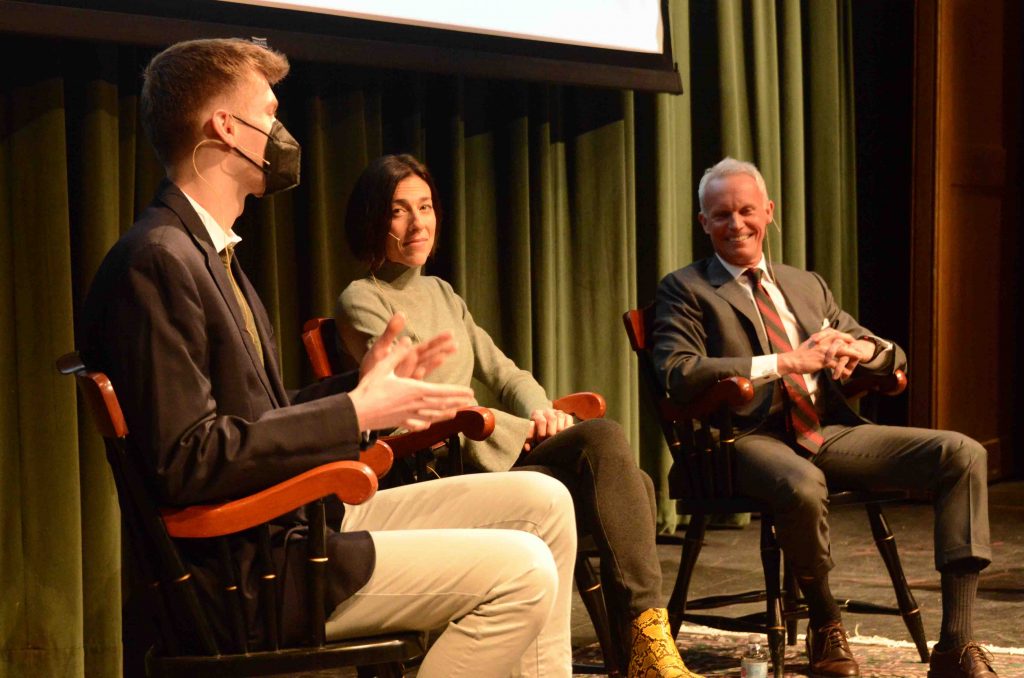Careers in Art History, and the Multivalence of Art: A Panel Hall With Three Experts
“In your art classes, and in this space, we often focus on art from the perspective of the artist—what someone creates, and why, and how,” began Headmaster Brennan in Hall on February 15. “Between the artist and the viewer, however, there is often a complex tapestry of activity, informed, shaped, and stewarded by experts such as those on our stage this morning.”
The morning’s panel of Hall speakers included three professionals who earned degrees in art history and have since taken that skill and passion in various directions. From the Smith Theater stage, Myles Garbarini ’13, Sue McCrory, and Paul Provost ’83 shared their experiences, trajectories, and insights with students and faculty.
Myles majored in art history at Yale after graduating from Roxbury Latin, focusing his thesis on the multidimensionality in Mikhail Vrubel’s paintings and ceramics. He conducted his primary research in Moscow and St. Petersburg, Russia, and this work earned him Yale’s Goodyear Fine Arts Award for excellence in his senior thesis. Until recently, Myles applied his passion and talent for art and learning as a technical art historian and research coordinator in the Scientific Research Department of Sotheby’s—the famed marketplace and auction house for fine art and luxury items. In that role, Myles coordinated analytical examinations of artworks worldwide, and executed technical imaging and infrared photography of artworks, resolving disputes about authenticity and condition. In Hall he spoke about that work through the example of a famed Botticelli painting that he and his colleagues worked on, revealing what they found in the painting’s centuries-old layers.
Dr. Sue McCrory—Roxbury Latin’s inspiring teacher of history, Art History, and Technology & Art—gained experience as an academic and historian in several different facets prior to arriving at RL. After earning her bachelor’s degree at Duke and her doctorate in History of Art and Architecture at Harvard, Dr. McCrory served as a teaching fellow at Harvard; as a historical guide in Rome, leading visitors through the Vatican Museums and Basilica of St. Peter; on the curatorial team of Harvard’s Fogg Art Museum; and as a consultant designing highly-specialized art-focused tours from Philadelphia to the Netherlands. In Hall she discussed some of the joys and challenges of pursuing a higher degree—both generally and in art history; what an advanced degree means experientially; and the variety of roles and opportunities available to an art historian.
Paul Provost—RL Class of 1983 and a member of the Board of Trustees—has more than 25 years’ experience in museums, businesses, and foundations. In 2019 he was appointed Chief Executive Officer of Art Bridges, an arts foundation with net assets of $1.5 billion and a mission to expand access to American Art across the country. Prior to this role, Paul served more than two decades in various management and executive roles at Christie’s—the premier American art auction enterprise. As Deputy Chairman at Christie’s, Paul served as an art world ambassador and lead negotiator for high-value art-related transactions and financial services. He has also been closely involved with World War II Holocaust and Restitution matters and other cultural property claims. He has lectured widely on art as an asset and international art market dynamics—topics on which he expanded in detail during the Hall, and in response to students’ questions afterward in Dr. McCrory’s AP Art History class as a guest later that afternoon. The focus of Paul’s portion of the presentation was multivalence—the value of artworks in various contexts. He walked students and faculty through this concept using the example of the 1863 Winslow Homer painting Home, Sweet Home, which Paul shepharded from the home of a private collector in New Jersey, through auction at Christie’s, to the National Gallery of Art in Washington, D.C., where it now lives. Paul earned his bachelor’s degree from Middlebury; his master’s in art history from Williams and the Clark Art Institute; and his doctorate in History of Art from Princeton.
The three art historians stressed for students the importance of paying attention to what you’re good at, and what you gravitate toward; the importance of visual literacy—of looking closely and decoding images; and, finally, the importance of following your passions, even when the trajectory ahead isn’t clear.
Watch the entirety of the panelists’ Hall on art and art history.

